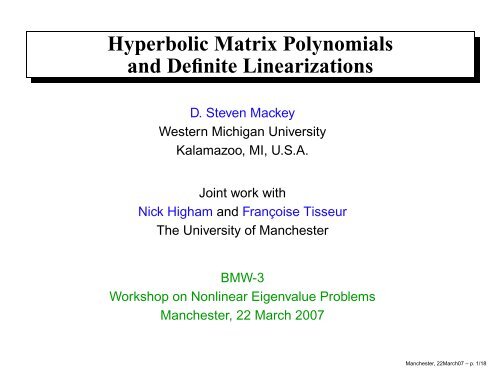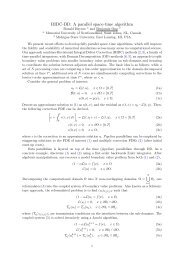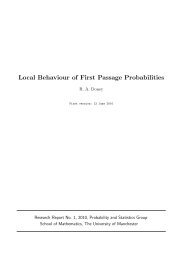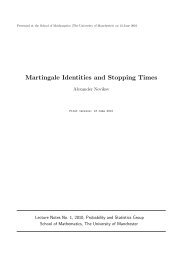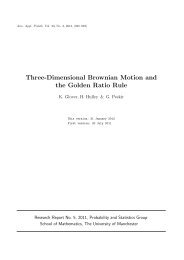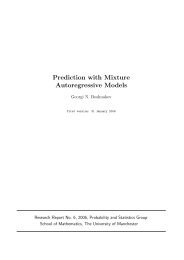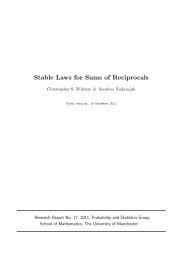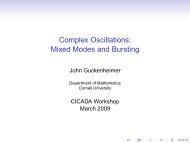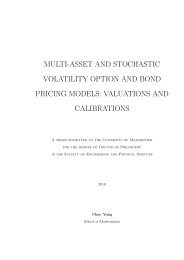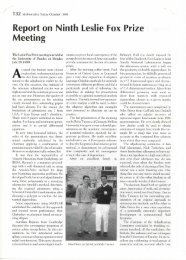Hyperbolic Matrix Polynomials and Definite Linearizations
Hyperbolic Matrix Polynomials and Definite Linearizations
Hyperbolic Matrix Polynomials and Definite Linearizations
You also want an ePaper? Increase the reach of your titles
YUMPU automatically turns print PDFs into web optimized ePapers that Google loves.
<strong>Hyperbolic</strong> <strong>Matrix</strong> <strong>Polynomials</strong><strong>and</strong> <strong>Definite</strong> <strong>Linearizations</strong>D. Steven MackeyWestern Michigan UniversityKalamazoo, MI, U.S.A.Joint work withNick Higham <strong>and</strong> Françoise TisseurThe University of ManchesterBMW-3Workshop on Nonlinear Eigenvalue ProblemsManchester, 22 March 2007Manchester, 22March07 – p. 1/18
<strong>Definite</strong> PencilsA st<strong>and</strong>ard way to define definite pencils –A Hermitian pencil L(λ) = λX + Y is definite if the Crawfordnumber γ(X,Y ) is nonzero, i.e. ifγ(X,Y ) := minz∈C n‖z‖ 2 =1√(z ∗ Xz) 2 + (z ∗ Y z) 2 > 0.This suffices to imply that all eigenvalues of L(λ) are real.Manchester, 22March07 – p. 3/18
<strong>Hyperbolic</strong> Quadratic <strong>Polynomials</strong>St<strong>and</strong>ard definition (goes back at least to Duffin, 1955, foroverdamped systems)For Hermitian Q(λ) = λ 2 A + λB + C <strong>and</strong> x ∈ C n , definea x := x ∗ Ax , b x := x ∗ Bx , c x := x ∗ Cx ,<strong>and</strong> consider D x (Q) := b 2 x − 4a x c x .Then Q is hyperbolic if A > 0 <strong>and</strong> D x (Q) > 0 for all x ∈ C n .Manchester, 22March07 – p. 4/18
<strong>Hyperbolic</strong> Quadratic <strong>Polynomials</strong>St<strong>and</strong>ard definition (goes back at least to Duffin, 1955, foroverdamped systems)For Hermitian Q(λ) = λ 2 A + λB + C <strong>and</strong> x ∈ C n , definea x := x ∗ Ax , b x := x ∗ Bx , c x := x ∗ Cx ,<strong>and</strong> consider D x (Q) := b 2 x − 4a x c x .Then Q is hyperbolic if A > 0 <strong>and</strong> D x (Q) > 0 for all x ∈ C n .The discriminant condition D x (Q) > 0 implies:x ∗ Q(λ)x = 0 has two real roots for any x ∈ C n ,hence all eigenvalues of Q are real.Manchester, 22March07 – p. 4/18
Extension to Higher DegreeVarious ways to extend [Markus, 1988] —Strongly <strong>Hyperbolic</strong>, .... , QuasihyperbolicHermitian P(λ) of degree k is strongly hyperbolic ifA k > 0the scalar polynomial p x (λ) = x ∗ P(λ)xhas k real roots for every x ∈ C n .Manchester, 22March07 – p. 5/18
Key Common PropertyAll eigenvalues are real <strong>and</strong> semisimple.Suggests that unification of notions may be possible.Manchester, 22March07 – p. 6/18
Other CharacterizationsLead us further towards a unified underst<strong>and</strong>ing.<strong>Definite</strong> Pencil L(λ) = λX + YL(µ) is a definite matrix for some µ ∈ R<strong>Hyperbolic</strong> Quadratic Q(λ) = λ 2 A + λB + CA > 0 <strong>and</strong> Q(γ) < 0 for some γ ∈ R.Manchester, 22March07 – p. 7/18
Other CharacterizationsLead us further towards a unified underst<strong>and</strong>ing.<strong>Definite</strong> PencilL(λ) = λX + YL(µ) is a definite matrix for some µ ∈ R<strong>Hyperbolic</strong> QuadraticQ(λ) = λ 2 A + λB + CA > 0 <strong>and</strong> Q(γ) < 0 for some γ ∈ R.Any two of the following implies the third1. Q(µ) > 0 for some µ ∈ R2. D x (Q) > 0 for all x ∈ C n3. Q(γ) < 0 for some γ ∈ RManchester, 22March07 – p. 7/18
Other CharacterizationsLead us further towards a unified underst<strong>and</strong>ing.<strong>Definite</strong> PencilL(λ) = λX + YL(µ) is a definite matrix for some µ ∈ R<strong>Hyperbolic</strong> QuadraticQ(λ) = λ 2 A + λB + CA > 0 <strong>and</strong> Q(γ) < 0 for some γ ∈ R.Any two of the following implies the third1. Q(µ) > 0 for some µ ∈ R2. D x (Q) > 0 for all x ∈ C n3. Q(γ) < 0 for some γ ∈ RStrongly <strong>Hyperbolic</strong> [Markus] P(λ) with A k > 0 <strong>and</strong>µ k−1 < µ k−2 < ... < µ 1 in R such that(−1) j P(µ j ) > 0.Manchester, 22March07 – p. 7/18
Homogeneous VariablesReplace λ by (α,β) ∈ R 2 such that α 2 + β 2 = 1.Correspondence: (α,β) ∈ R 2 ↔ λ = α/β when β ≠ 0(±1, 0) ↔ λ = ”∞”L(λ) = λX + Y L(α,β) = αX + βYQ(λ) = λ 2 A + λB + C Q(α,β) = α 2 A + αβB + β 2 C“Circle picture” in α,β-planeManchester, 22March07 – p. 8/18
<strong>Definite</strong>ness DiagramsDiagrammatic renderings of previously known resultsDuffin(1955)Lancaster(1966, 1991)Markus(1988)Guo/Lancaster(2005)And many others ...ExamplesManchester, 22March07 – p. 9/18
Unifying DefinitionThese diagrams suggest a definition that(mildly) generalizes (strong) hyperbolicity,<strong>and</strong> unifies definite pencils with hyperbolic polynomials.Manchester, 22March07 – p. 10/18
Unifying DefinitionThese diagrams suggest a definition that(mildly) generalizes (strong) hyperbolicity,<strong>and</strong> unifies definite pencils with hyperbolic polynomials.Definition A Hermitian polynomial P(λ) of degree k is saidto be completely definite if there exist µ 1 < µ 2 < ... < µ k inR ∪ {∞} such thateach P(µ i ) is a definite matrix,the definiteness “parity” is strictly alternating.Completely definite polynomials have the same spectralproperties as strongly hyperbolic polynomials:eigenvalues all real <strong>and</strong> semisimple, .....Manchester, 22March07 – p. 10/18
Example[ ] [ ]Q(λ) = λ 2 A+λB +C = λ 2 −3 −1 6 3+λ +−1 2 3 −10[0]−2−2 9is completely definite even though A,B,C are all indefinite,since Q(1) > 0 <strong>and</strong> Q(3) < 0.Manchester, 22March07 – p. 11/18
L(λ) = λX + Y,<strong>Linearizations</strong>X,Y ∈ C kn×knis a linearization of P(λ) = ∑ ki=0 λi A i ifE(λ)L(λ)F(λ) =for some unimodular E(λ) <strong>and</strong> F(λ).[ ] P(λ) 00 I (k−1)nManchester, 22March07 – p. 12/18
L(λ) = λX + Y,<strong>Linearizations</strong>X,Y ∈ C kn×knis a linearization of P(λ) = ∑ ki=0 λi A i ifE(λ)L(λ)F(λ) =for some unimodular E(λ) <strong>and</strong> F(λ).[ ] P(λ) 00 I (k−1)nExampleFirst companion form linearization for quadratic P :( [ ] [ ])A2 0 A1 AE(λ) λ + 0F(λ) =0 I −I 0[λ 2 A 2 + λA 1 + A 0 00 I].Manchester, 22March07 – p. 12/18
Why a <strong>Definite</strong> Linearization?Why we might want a definite linearization for a completelydefinite matrix polynomial:Structure-preservingGood Algorithms are readily available for definitepencilsManchester, 22March07 – p. 13/18
A Good Place to LookL 1 (P) — a large vector space of pencils associated to PL(λ)(Λ ⊗ I n ) = v ⊗ P(λ)where Λ = [λ k−1 ,...,λ, 1] T <strong>and</strong> v ∈ C k . [MMMM, 2006]Generalizes the first companion form.Almost all pencils in L 1 (P) are linearizations for P .L(λ) ∈ L 1 (P) is a linearization for P iff L is regular.For Hermitian P , all the Hermitian pencils in L 1 (P) forma real k-dim’l subspace H(P) ⊂ L 1 (P). (k = deg P )Each pencil in H(P) is uniquely determined by thevector v ∈ R k . [HMMT, 2006]Manchester, 22March07 – p. 14/18
A Good Place to LookAre there any definite pencils in H(P)?Any such pencil will be regular, hence a (definite)linearization for P .DefineD(P) = {All definite pencils in H(P)}Is D(P) non-empty?Manchester, 22March07 – p. 15/18
<strong>Definite</strong> Linearization TheoremFor any completely definite P , D(P) is non-empty.Manchester, 22March07 – p. 16/18
<strong>Definite</strong> Linearization TheoremFor any completely definite P , D(P) is non-empty.Surprise: non-emptiness of D(P) characterizes theproperty of complete definiteness of P .TheoremA Hermitian matrix polynomial P(λ) is completely definiteif <strong>and</strong> only ifP(λ) has a definite linearization in L 1 (P) .Manchester, 22March07 – p. 16/18
Characterization of D(P)Recall: pencils in H(P) uniquely determined by v ∈ R k .Define scalar polynomial p(λ;v) := v T Λ = ∑ ki=1 v iλ k−i ofdegree k − 1; by convention p(λ;v) has a “root at ∞”whenever v 1 = 0.TheoremSuppose P is completely definite of degree k, <strong>and</strong> v ∈ R kcorresponds to L(λ) = λX + Y ∈ H(P). ThenL ∈ D(P) iff the k − 1 roots of p(x;v) are real (incl. ∞),simple, <strong>and</strong> lie in distinct definiteness intervals for P .The matrix αX + βY is definite iffL ∈ D(P)(α,β) lies in the unique definiteness interval for P notoccupied by any root of p(λ;v).Manchester, 22March07 – p. 17/18
CommentsProofs of these theorems are long.Strategy: Exploit the special block structure of pencilsin H(P) to reduce αX + βY to block-diagonal form.(Use nonsingular ∗-congruence to preserve theHermitian structure.)Unification of notions of definite <strong>and</strong> hyperbolicUnified definition via a common generalizationStructure-preserving linearizationManchester, 22March07 – p. 18/18


